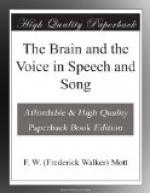There is, however, a direct functional association between the auditory and glosso-kinaesthetic (sense of movement of the tongue) centres on the one hand and the visual and cheiro-kinaesthetic (sense of movement of the hand) on the other. No less intimate must be the connection between the auditory word-centre and the visual word-centre; they must necessarily be called into association actively in successive units of time, as in reading aloud or writing from dictation. Educated deaf mutes think with revived visual symbols either of lips or fingers. Words are to a great extent symbols whereby we carry on thought, and thinking becomes more elaborate and complex as we rise in the scale of civilisation, because more and more are verbal symbols instituted for concrete visual images.
In which portion of the brain are words primarily and principally revived during the process of thinking? I have already alluded to the views of Stricker and those who follow him, viz. that words are the revived images of the feelings of the sense of movement, caused by the alteration in the tension of the muscles of articulation occurring during speech, with or without phonation. There is another which I think the correct view, that words are revived in thought primarily as auditory images, so that the sense of hearing is essential for articulation as well as phonation; the two operations of the vocal organ as an instrument of the mind being inseparable. The arguments in favour of this are:—
1. The part of the brain concerned with the sense of hearing develops earlier and the nerve fibres found in this situation are myelinated[1] at an earlier period of development of the brain than the portion connected with the sense of movement of the muscles of articulation.
[Footnote 1: The covering of the fibres by a sheath of phosphoretted fat serving to insulate the conductile portion of the nerve is an indication that the fibre has commenced to function as a conductor of nervous impulses.]
2. As a rule, the child’s first ideas of language come through the sense of hearing; articulate speech is next evolved, in fact the child speaks only that which it has heard; it learns first to repeat the names of persons and objects with which it comes into relation, associating visual images with auditory symbols.




